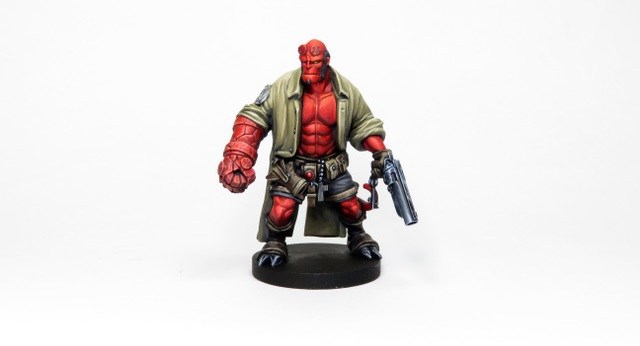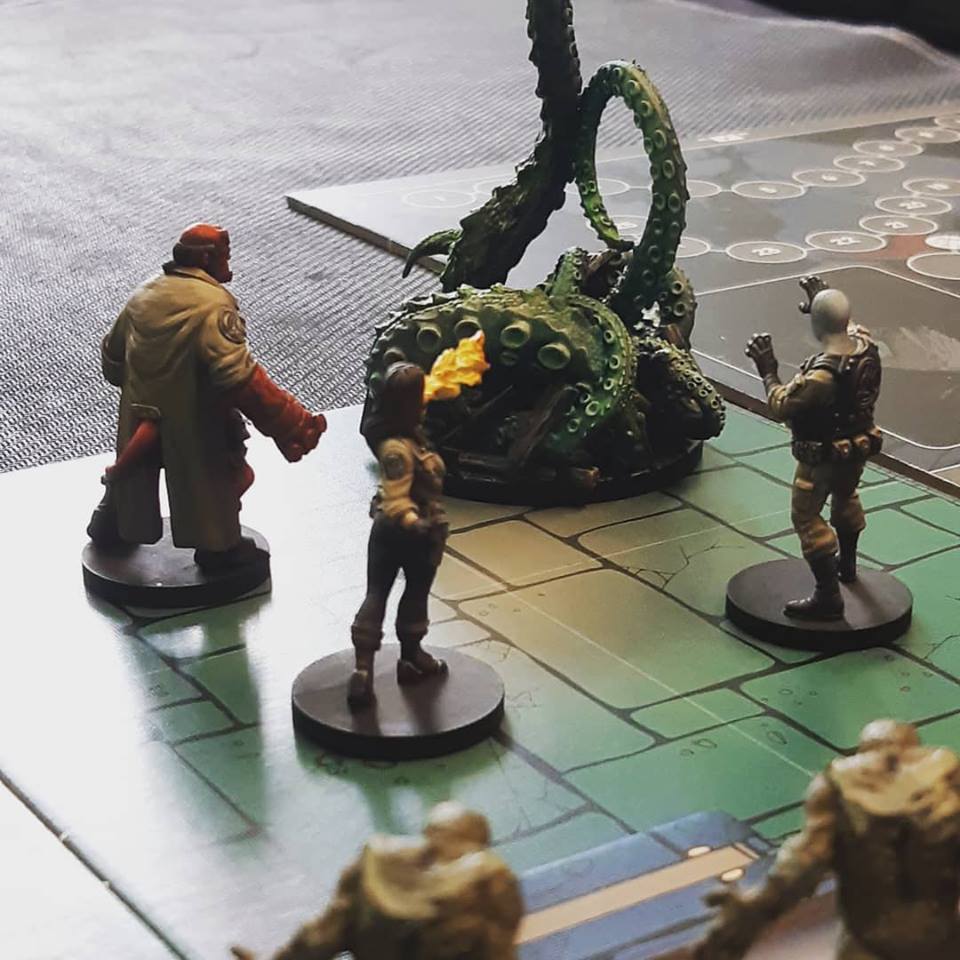
Developing Hellboy: The Board Game – Agent Actions
It’s James again here and today I’ve agreed to divulge some secrets about how Agent Actions work. At the start of each round in a game of Hellboy: The Board Game, each player takes a trio of Action Cubes and puts them on their Agent Card. These cubes can then be spent in the Agent phase, each one fuelling an Action.
What’s really interesting is that there’s no set player order – the Cubes can be spent however you wish. Hellboy could use a cube to shoot a Frog Monster, then Hellboy could leap in to punch it, then Abe could follow… it’s entirely freeform, which leads to some very interesting discussion around the table!

There are plenty of Actions to choose from, some of which
you might be using more than others. Here’s a nifty breakdown…
MOVE
This is the most straightforward Action, letting an agent
move up to two areas. However, even this is not without an interesting wrinkle.
If at any point you try to leave an area that’s occupied by any enemies, you
have a decision to make. Either you try to dodge past them, taking a point of
Damage in the process, or you let them follow you into the next area. If
another agent in your area is feeling gracious, they can discard one of their
own Action Cubes to distract an enemy and give you the chance to slip away.
This is the first of many situations where you can spend Action Cubes together,
giving a real feeling of teamwork and interactivity between the players.
FIGHT
This action lets you attack an enemy in your area by making
a test against your FIGHT skill. Other enemies in your area will downgrade your
dice, while other agents in your area can discard Action Cubes to upgrade your
dice. Again, this is really important – a character like Johann, for example,
might not be particularly great in a fight, but he can provide assists just as
well as anyone else.
SHOOT
This one’s similar to Fight, but it uses your SHOOT skill,
requires a Ranged Weapon and targets enemies in other areas. Agents can’t
assist you here – in fact, if there’s another agent in your target area or in
the path of your shot, they’ll downgrade one of your dice unless they discard
an Action Cube to get out of the way.
EXAMINE
One of the things that really makes Hellboy: The Board Game
stand out against a lot of other games that look similar is its focus on
investigation. Throughout a Case the agents will have multiple opportunities to
advance the Information Gathered track by examining Clues (making a test
against their EXAMINE skill), hoping to gain valuable Insights which will help
them in the Confrontation. Also, the Case File deck will often throw in
checkpoints in the form of Points of Interest – the players will need to search
the area for the appropriate point of interest then successfully examine it in
order to turn the next card in the deck.

EXPLORE
Agents can use this free action while standing in a doorway
that leads to an unexplored area, letting them flip and set up its Encounter
Card. Exploration is key to progress (and, as you should know by now, progress
is something you always need to be thinking about), but you should be careful –
explore a new area too late in the turn and you’re bound to get jumped by some
bad guys before you have a chance to clear them all out.
CLEAR
As the game goes by, the board can get clogged up by things
like Frog Swarms (which, being awful harbingers of ancient evil – don’t ask –
can cause the Impending Doom track) and Fire (which can burn important things
like clue tokens, useful scenery and the more flammable variety of agent).
Clear actions are your chance to get rid of these annoyances. For example, a
game where Johann’s player spent several turns in a row making increasingly
passive-aggressive Clear actions, giving Liz’s player vicious side-eye and
muttering things like “oh no, you carry on, I’ll just put this enormous inferno
out, shall I?” and “it’s fine, not to worry, everyone’s obviously just as
fireproof as you are”. The important thing to remember is that this game’s
fully co-operative. FULLY co-operative.
TRADE
At the start of each Case you’ll kit your team out with
everything from big guns to lucky charms, but sometimes you’ll get halfway
through and realise someone else might put your equipment to better use. The
Trade action lets you swap things around and keep everyone happy.
Those are the seven basic actions that are available to
everyone, but each Agent also has a set of Unique Actions – things that only
they can do. Some of them are more powerful versions of the standard actions;
Abe’s Dash, for example, is a once-per-round Move that lets him go three areas
rather than two, and ignores enemies. Other actions are truly unique, though,
like Hellboy’s Throw Furniture (which creates some hilarious moments of group
discussion – “I reckon I should throw that bookcase at those Frog monsters.”
“Wait, I haven’t had a chance to examine it yet!” “Yeah, but… it’ll kill them.”
“Seriously, we need that information!” “Yeah, I’m throwing it.” “Argh!”)
So, there you have it. Actions in a nutshell. We’ll have one more blog next week covering the final aspects of Hellboy: The Board Game but I hope you’ve enjoyed the insights so far.
Hellboy: The Board Game is available to order NOW from the Mantic website. The retail version will be launched on April 27th in all good game stores.
The post Developing Hellboy: The Board Game – Agent Actions appeared first on Mantic Blog.
